Baphomet
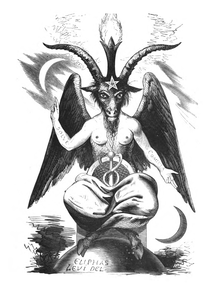
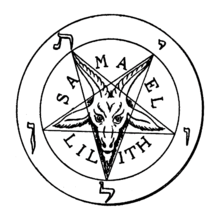
| Part of a series on the |
| Knights Templar |
|---|
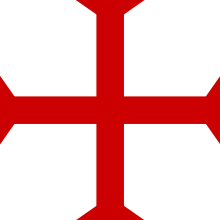 |
|
Poor Fellow-Soldiers of Christ and of the Temple of Solomon |
| Overview |
| Papal bulls |
|
| Locations |
| Successors |
| Cultural references |
| See also |
|
|
|
Baphomet (/ˈbæfoʊmɛt/; from Medieval Latin Baphometh, Baffometi, Occitan Bafometz) is a deity that the Knights Templar were falsely accused of worshipping and that subsequently was incorporated into disparate occult and mystical traditions.
History
The name Baphomet first appeared in trial transcripts for the Inquisition of the Knights Templar starting in 1307.[1] It first came into popular English usage in the 19th century during debate and speculation on the reasons for the suppression of the Templars.[2]
Since 1856, the name Baphomet has been associated with a "Sabbatic Goat" image drawn by Eliphas Levi[3] which contains binary elements representing the "sum total of the universe" (e.g. male and female, good and evil, on and off, etc.).[4] On one hand, Lévi's intention was to symbolize his concept of "the equilibrium of the opposites" that was essential to his magnetistic notion of the Astral Light; on the other hand, the Baphomet represents a tradition that should result in a perfect social order.[5]
The name Baphomet (apparently from mis-hearing the Saracens reciting the name Mohammed) appeared in July 1098 in a letter by the crusader Anselm of Ribemont:
|
|
A chronicler of the First Crusade, Raymond of Aguilers, called the mosques Bafumarias.[8] The name Bafometz later appeared around 1195 in the Occitan poems "Senhors, per los nostres peccatz" by the troubadour Gavaudan.[9] Around 1250 a poem bewailing the defeat of the Seventh Crusade by Austorc d'Aorlhac refers to Bafomet.[10] De Bafomet is also the title of one of four surviving chapters of an Occitan translation of Ramon Llull's earliest known work, the Libre de la doctrina pueril, "book on the instruction of children".[11]
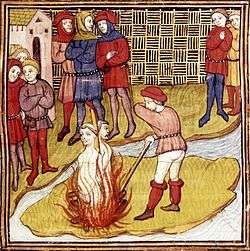
When the medieval order of the Knights Templar was suppressed by King Philip IV of France, on Friday October 13, 1307, Philip had many French Templars simultaneously arrested, and then tortured into confessions. Over 100 different charges had been leveled against the Templars. Most of them were dubious, as they were the same charges that were leveled against the Cathars[12] and many of King Philip's enemies; he had earlier kidnapped Pope Boniface VIII and charged him with near identical offenses of heresy, spitting and urinating on the cross, and sodomy. Yet Malcolm Barber observes that historians "find it difficult to accept that an affair of such enormity rests upon total fabrication".[13] The "Chinon Parchment suggests that the Templars did indeed spit on the cross," says Sean Martin, and that these acts were intended to simulate the kind of humiliation and torture that a Crusader might be subjected to if captured by the Saracens, where they were taught how to commit apostasy "with the mind only and not with the heart".[14] Similarly, Michael Haag[15] suggests that the simulated worship of Baphomet did indeed form part of a Templar initiation ritual.
The indictment (acte d'accusation) published by the court of Rome set forth ... "that in all the provinces they had idols, that is to say, heads, some of which had three faces, others but one; sometimes, it was a human skull ... That in their assemblies, and especially in their grand chapters, they worshipped the idol as a god, as their saviour, saying that this head could save them, that it bestowed on the order all its wealth, made the trees flower, and the plants of the earth to sprout forth."[1]
The name Baphomet comes up in several of these confessions. Peter Partner states in his 1987 book The Knights Templar and their Myth, "In the trial of the Templars one of their main charges was their supposed worship of a heathen idol-head known as a 'Baphomet' ('Baphomet' = Mahomet)."[16] The description of the object changed from confession to confession. Some Templars denied any knowledge of it. Others, under torture, described it as being either a severed head, a cat, or a head with three faces.[17] The Templars did possess several silver-gilt heads as reliquaries,[18] including one marked capud lviiim,[19] another said to be St. Euphemia,[20] and possibly the actual head of Hugues de Payens.[21] The claims of an idol named Baphomet were unique to the Inquisition of the Templars.[22][23] Karen Ralls, author of the Knights Templar Encyclopedia, argues that it is significant that "no specific evidence [of Baphomet] appears in either the Templar Rule or in other medieval period Templar documents."[24]
Gauserand de Montpesant, a knight of Provence, said that their superior showed him an idol made in the form of Baffomet; another, named Raymond Rubei, described it as a wooden head, on which the figure of Baphomet was painted, and adds, "that he worshipped it by kissing its feet, and exclaiming, 'Yalla,' which was," he says, "verbum Saracenorum," a word taken from the Saracens. A templar of Florence declared that, in the secret chapters of the order, one brother said to the other, showing the idol, "Adore this head—this head is your god and your Mahomet."[25]
Modern scholars such as Peter Partner and Malcolm Barber agree that the name of Baphomet was an Old French corruption of the name Muhammad, with the interpretation being that some of the Templars, through their long military occupation of the Outremer, had begun incorporating Islamic ideas into their belief system, and that this was seen and documented by the Inquisitors as heresy.[26] Alain Demurger, however, rejects the idea that the Templars could have adopted the doctrines of their enemies.[27] Helen Nicholson writes that the charges were essentially "manipulative"—the Templars "were accused of becoming fairy-tale Muslims."[27] Medieval Christians believed that Muslims were idolatrous and worshipped Muhammad as a god, with mahomet becoming mammet in English, meaning an idol or false god.[28] This idol-worship is attributed to Muslims in several chansons de geste. For example, one finds the gods Bafum e Travagan in a Provençal poem on the life of St. Honorat, completed in 1300.[29] In the Chanson de Simon Pouille, written before 1235, a Saracen idol is called Bafumetz.[30]
Alternative etymologies
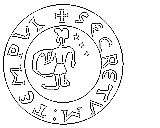
While modern scholars and the Oxford English Dictionary[32] state that the origin of the name Baphomet was a probable Old French version of "Mahomet",[16][26] alternative etymologies have also been proposed.
According to Pierre Klossowski in Le Baphomet (1965, Editions Mercure de France, Paris; translated into English by Sophie Hawkes and published as The Baphomet in 1988 by Eridanos Press): “The Baphomet has diverse etymologies… the three phonemes that constitute the denomination are also said to signify, in coded fashion, Basileus philosophorum metaloricum: the sovereign of metallurgical philosophers, that is, of the alchemical laboratories that were supposedly established in various chapters of the Temple. The androgynous nature of the figure apparently goes back to the Adam Kadmon of the Chaldeans, which one finds in the Zohar” (pages 164-165).
In the 18th century, speculative theories arose that sought to tie the Knights Templar with the origins of Freemasonry.[33] Bookseller, Freemason and Illuminatus[34] Christoph Friedrich Nicolai (1733–1811), in Versuch über die Beschuldigungen welche dem Tempelherrenorden gemacht worden, und über dessen Geheimniß (1782), was the first to claim that the Templars were Gnostics, and that "Baphomet" was formed from the Greek words βαφη μητȢς, baphe metous, to mean Taufe der Weisheit, "Baptism of Wisdom".[35] Nicolai "attached to it the idea of the image of the supreme God, in the state of quietude attributed to him by the Manichaean Gnostics", according to F. J. M. Raynouard, and "supposed that the Templars had a secret doctrine and initiations of several grades" which "the Saracens had communicated ... to them."[36] He further connected the figura Baffometi with the pentagram of Pythagoras:
What properly was the sign of the Baffomet, 'figura Baffometi,' which was depicted on the breast of the bust representing the Creator, cannot be exactly determined ... I believe it to have been the Pythagorean pentagon (Fünfeck) of health and prosperity: ... It is well known how holy this figure was considered, and that the Gnostics had much in common with the Pythagoreans. From the prayers which the soul shall recite, according to the diagram of the Ophite-worshippers, when they on their return to God are stopped by the Archons, and their purity has to be examined, it appears that these serpent-worshippers believed they must produce a token that they had been clean on earth. I believe that this token was also the holy pentagon, the sign of their initiation (τελειας βαφης μετεος).[37]
Émile Littré (1801–1881) in Dictionnaire de la langue francaise asserted that the word was cabalistically formed by writing backward tem. o. h. p. ab, an abbreviation of templi omnium hominum pacis abbas, 'abbot' or 'father of the temple of peace of all men.' His source is the "Abbé Constant", which is to say, Alphonse-Louis Constant, the real name of Eliphas Levi.
Hugh J. Schonfield (1901–1988),[38] one of the scholars who worked on the Dead Sea Scrolls, argued in his book The Essene Odyssey that the word "Baphomet" was created with knowledge of the Atbash substitution cipher, which substitutes the first letter of the Hebrew alphabet for the last, the second for the second last, and so on. "Baphomet" rendered in Hebrew is בפומת; interpreted using Atbash, it becomes שופיא, which can be interpreted as the Greek word "Sophia", meaning wisdom. This theory is an important part of the plot of the novel The Da Vinci Code.
Joseph Freiherr von Hammer-Purgstall

In 1818, the name Baphomet appeared in the essay by the Viennese Orientalist Joseph Freiherr von Hammer-Purgstall, Mysterium Baphometis revelatum, seu Fratres Militiæ Templi, qua Gnostici et quidem Ophiani, Apostasiæ, Idoloduliæ et Impuritatis convicti, per ipsa eorum Monumenta[39] ("Discovery of the Mystery of Baphomet, by which the Knights Templars, like the Gnostics and Ophites, are convicted of Apostasy, of Idolatry and of moral Impurity, by their own Monuments"), which presented an elaborate pseudohistory constructed to discredit Templarist Masonry and, by extension, Freemasonry.[40] Following Nicolai, he argued, using as archaeological evidence "Baphomets" faked by earlier scholars and literary evidence such as the Grail romances, that the Templars were Gnostics and the "Templars' head" was a Gnostic idol called Baphomet.
His chief subject is the images which are called Baphomet ... found in several museums and collections of antiquities, as in Weimar ... and in the imperial cabinet in Vienna. These little images are of stone, partly hermaphrodites, having, generally, two heads or two faces, with a beard, but, in other respects, female figures, most of them accompanied by serpents, the sun and moon, and other strange emblems, and bearing many inscriptions, mostly in Arabic ... The inscriptions he reduces almost all to Mete[, which] ... is, according to him, not the Μητις of the Greeks, but the Sophia, Achamot Prunikos of the Ophites, which was represented half man, half woman, as the symbol of wisdom, unnatural voluptuousness and the principle of sensuality ... He asserts that those small figures are such as the Templars, according to the statement of a witness, carried with them in their coffers. Baphomet signifies Βαφη Μητεος, baptism of Metis, baptism of fire,[41] or the Gnostic baptism, an enlightening of the mind, which, however, was interpreted by the Ophites, in an obscene sense, as fleshly union ... the fundamental assertion, that those idols and cups came from the Templars, has been considered as unfounded, especially as the images known to have existed among the Templars seem rather to be images of saints.[42]
Hammer's essay did not pass unchallenged, and F. J. M. Raynouard published an "Etude sur 'Mysterium Baphometi revelatum'" in Journal des savants the following year.[43] Charles William King criticized Hammer saying he had been deceived by "the paraphernalia of ... Rosicrucian or alchemical quacks,"[44] and Peter Partner agreed that the images "may have been forgeries from the occultist workshops."[45] At the very least, there was little evidence to tie them to the Knights Templar—in the 19th century some European museums acquired such pseudo-Egyptian objects, which were catalogued as "Baphomets" and credulously thought to have been idols of the Templars.[46]
Eliphas Lévi

Later in the 19th century, the name of Baphomet became further associated with the occult. Eliphas Levi published Dogme et Rituel de la Haute Magie ("Dogma and Rituals of High Magic") as two volumes (Dogme 1854, Rituel 1856), in which he included an image he had drawn himself which he described as Baphomet and "The Sabbatic Goat", showing a winged humanoid goat with a pair of breasts and a torch on its head between its horns (illustration, top). This image has become the best-known representation of Baphomet. Lévi considered the Baphomet to be a depiction of the absolute in symbolic form and explicated in detail his symbolism in the drawing that served as the frontispiece:
The goat on the frontispiece carries the sign of the pentagram on the forehead, with one point at the top, a symbol of light, his two hands forming the sign of occultism, the one pointing up to the white moon of Chesed, the other pointing down to the black one of Geburah. This sign expresses the perfect harmony of mercy with justice. His one arm is female, the other male like the ones of the androgyne of Khunrath, the attributes of which we had to unite with those of our goat because he is one and the same symbol. The flame of intelligence shining between his horns is the magic light of the universal balance, the image of the soul elevated above matter, as the flame, whilst being tied to matter, shines above it. The beast's head expresses the horror of the sinner, whose materially acting, solely responsible part has to bear the punishment exclusively; because the soul is insensitive according to its nature and can only suffer when it materializes. The rod standing instead of genitals symbolizes eternal life, the body covered with scales the water, the semi-circle above it the atmosphere, the feathers following above the volatile. Humanity is represented by the two breasts and the androgyne arms of this sphinx of the occult sciences.[47]
Witches' Sabbath
Lévi's depiction of Baphomet is similar to that of The Devil in early Tarot.[48] Lévi, working with correspondences different from those later used by S. L. MacGregor Mathers, "equated the Devil Tarot key with Mercury," giving "his figure Mercury's caduceus, rising like a phallus from his groin."[49]
Lévi believed that the alleged devil worship of the medieval Witches' Sabbath was a perpetuation of ancient pagan rites. A goat with a candle between its horns appears in medieval witchcraft records,[50] and other pieces of lore are cited in Dogme et Rituel.
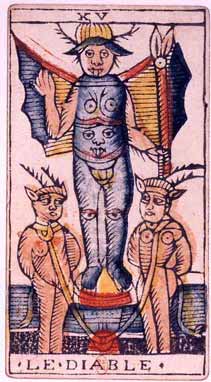
Below this figure we read a frank and simple inscription—THE DEVIL. Yes, we confront here that phantom of all terrors, the dragon of the all theogenies, the Ahriman of the Persians, the Typhon of the Egyptians, the Python of the Greeks, the old serpent of the Hebrews, the fantastic monster, the nightmare, the Croquemitaine, the gargoyle, the great beast of the Middle Ages, and—worse than all these—the Baphomet of the Templars, the bearded idol of the alchemist, the obscene deity of Mendes, the goat of the Sabbath. The frontispiece to this ‘Ritual’ reproduces the exact figure of the terrible emperor of night, with all his attributes and all his characters.... Yes, in our profound conviction, the Grand Masters of the Order of Templars worshipped the Baphomet, and caused it to be worshipped by their initiates; yes, there existed in the past, and there may be still in the present, assemblies which are presided over by this figure, seated on a throne and having a flaming torch between the horns. But the adorers of this sign do not consider, as do we, that it is a representation of the devil; on the contrary, for them it is that of the god Pan, the god of our modern schools of philosophy, the god of the Alexandrian theurgic school and of our own mystical Neoplatonists, the god of Lamartine and Victor Cousin, the god of Spinoza and Plato, the god of the primitive Gnostic schools; the Christ also of the dissident priesthood.... The mysteries of the Sabbath have been variously described, but they figure always in grimoires and in magical trials; the revelations made on the subject may be classified under three heads—1. those referring to a fantastic and imaginary Sabbath; 2. those which betray the secrets of the occult assemblies of veritable adepts; 3. revelations of foolish and criminal gatherings, having for their object the operations of black magic.[51]
Lévi's Baphomet, for all its modern fame, does not match the historical descriptions from the Templar trials, although it may also have been partly inspired by grotesque carvings on the Templar churches of Lanleff in Brittany and Saint-Merri in Paris, which depict squatting bearded men with bat wings, female breasts, horns and the shaggy hindquarters of a beast,[52] as well as Eugène Viollet-le-Duc's vivid gargoyles that were added to Notre-Dame de Paris about the same time as Lévi's illustration.
Contemporary context of socialism, romanticism, and magnetism
Lévi's references to the School of Alexandria and the Templars can be explained against the background of debates about the origins and character of true Christianity. It has been pointed out that these debates included contemporary forms of Romantic Socialism, or Utopian Socialism, which were seen as the heirs of the Gnostics, Templars, and other mystics. Lévi, being himself an adherent of these schools since the 1840s, regarded the socialists and Romantics (such as Lamartine) as the successors of this alleged tradition of true religion. In fact, his narrative mirrors historiographies of socialism, including the Histoire des Montagnards (1847) by his best friend and political comrade Alphonse Esquiros. Consequently, the Baphomet is depicted by Lévi as the symbol of a revolutionary heretical tradition that would soon lead to the "emancipation of humanity" and the establishment of a perfect social order.[53]
In Lévi's writings, the Baphomet does not only express a historical-political tradition, but also occult natural forces that are explained by his magical theory of the Astral Light. He developed this notion in the context of what has been called "spiritualist magnetism": theories that stressed the religious implications of magnetism. Often, their representatives were socialists that believed in the social consequences of a "synthesis" of religion and science that was to be achieved by the means of magnetism.[54] Spiritualist mangetists with a socialist background include the Baron du Potet and Henri Delaage, who served as main sources for Lévi. At the same time, Lévi polemicized against famed Catholic authors such as Jules-Eudes de Mirville and Roger Gougenot des Mousseaux who regarded magnetism as the workings of demons and other infernal powers.[55] The paragraph just before the passage cited in the previous section has to be seen against this background:
Let us state now for the edification of the vulgar, for the satisfaction of M. le Comte de Mirville, for the justification of the demonologist Bodin, for the greater glory of the Church, which persecuted Templars, burnt magicians, excommunicated Freemasons, &c. let us state boldly and precisely that all the inferior initiates of the occult sciences and profaners of the great arcanum, not only did in the past, but do now, and will ever, adore what is signified by this alarming symbol.[56]
Goat of Mendes
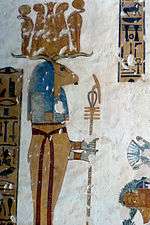
Lévi called his image "The Goat of Mendes", possibly following Herodotus' account[57] that the god of Mendes—the Greek name for Djedet, Egypt—was depicted with a goat's face and legs. Herodotus relates how all male goats were held in great reverence by the Mendesians, and how in his time a woman publicly copulated with a goat.[58] E. A. Wallis Budge writes,
At several places in the Delta, e.g. Hermopolis, Lycopolis, and Mendes, the god Pan and a goat were worshipped; Strabo, quoting (xvii. 1, 19) Pindar, says that in these places goats had intercourse with women, and Herodotus (ii. 46) instances a case which was said to have taken place in the open day. The Mendisians, according to this last writer, paid reverence to all goats, and more to the males than to the females, and particularly to one he-goat, on the death of which public mourning is observed throughout the whole Mendesian district; they call both Pan and the goat Mendes, and both were worshipped as gods of generation and fecundity. Diodorus (i. 88) compares the cult of the goat of Mendes with that of Priapus, and groups the god with the Pans and the Satyrs. The goat referred to by all these writers is the famous Mendean Ram, or Ram of Mendes, the cult of which was, according to Manetho, established by Kakau, the king of the IInd dynasty.[59]
Historically, the deity that was venerated at Egyptian Mendes was a ram deity, Banebdjedet (literally Ba of the lord of djed, and titled "the Lord of Mendes"), who was the soul of Osiris. Lévi combined the images of the Tarot of Marseilles Devil card and refigured the ram Banebdjed as a he-goat, further imagined by him as "copulator in Anep and inseminator in the district of Mendes".
Aleister Crowley
The Baphomet of Lévi was to become an important figure within the cosmology of Thelema, the mystical system established by Aleister Crowley in the early twentieth century. Baphomet features in the Creed of the Gnostic Catholic Church recited by the congregation in The Gnostic Mass, in the sentence: "And I believe in the Serpent and the Lion, Mystery of Mysteries, in His name BAPHOMET."[60]
In Magick (Book 4), Crowley asserted that Baphomet was a divine androgyne and "the hieroglyph of arcane perfection": Seen as that which reflects. "What occurs above so reflects below, or As above so below"
The Devil does not exist. It is a false name invented by the Black Brothers to imply a Unity in their ignorant muddle of dispersions. A devil who had unity would be a God... 'The Devil' is, historically, the God of any people that one personally dislikes... This serpent, SATAN, is not the enemy of Man, but He who made Gods of our race, knowing Good and Evil; He bade 'Know Thyself!' and taught Initiation. He is 'The Devil' of The Book of Thoth, and His emblem is BAPHOMET, the Androgyne who is the hieroglyph of arcane perfection... He is therefore Life, and Love. But moreover his letter is ayin, the Eye, so that he is Light; and his Zodiacal image is Capricornus, that leaping goat whose attribute is Liberty.[61]
For Crowley, Baphomet is further a representative of the spiritual nature of the spermatozoa while also being symbolic of the "magical child" produced as a result of sex magic.[62] As such, Baphomet represents the Union of Opposites, especially as mystically personified in Chaos and Babalon combined and biologically manifested with the sperm and egg united in the zygote.
Crowley proposed that Baphomet was derived from "Father Mithras". In his Confessions he describes the circumstances that led to this etymology:[63]
I had taken the name Baphomet as my motto in the O.T.O. For six years and more I had tried to discover the proper way to spell this name. I knew that it must have eight letters, and also that the numerical and literal correspondences must be such as to express the meaning of the name in such a ways as to confirm what scholarship had found out about it, and also to clear up those problems which archaeologists had so far failed to solve ... One theory of the name is that it represents the words βαφὴ μήτεος, the baptism of wisdom; another, that it is a corruption of a title meaning "Father Mithras". Needless to say, the suffix R supported the latter theory. I added up the word as spelt by the Wizard. It totalled 729. This number had never appeared in my Cabbalistic working and therefore meant nothing to me. It however justified itself as being the cube of nine. The word κηφας, the mystic title given by Christ to Peter as the cornerstone of the Church, has this same value. So far, the Wizard had shown great qualities! He had cleared up the etymological problem and shown why the Templars should have given the name Baphomet to their so-called idol. Baphomet was Father Mithras, the cubical stone which was the corner of the Temple.
Modern interpretations and usage
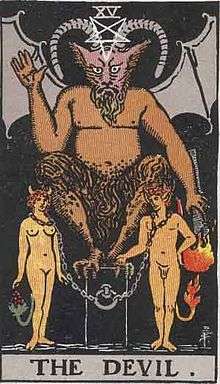
Lévi's Baphomet is the source of the later Tarot image of the Devil in the Rider-Waite design.[3] The concept of a downward-pointing pentagram on its forehead was enlarged upon by Lévi in his discussion (without illustration) of the Goat of Mendes arranged within such a pentagram, which he contrasted with the microcosmic man arranged within a similar but upright pentagram.[64] The actual image of a goat in a downward-pointing pentagram first appeared in the 1897 book La Clef de la Magie Noire by Stanislas de Guaita.[65] It was this image that was later adopted as the official symbol—called the Sigil of Baphomet—of the Church of Satan, and continues to be used among Satanists.[66]
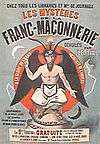
Baphomet, as Lévi's illustration suggests, has occasionally been portrayed as a synonym of Satan or a demon, a member of the hierarchy of Hell. Baphomet appears in that guise as a character in James Blish's The Day After Judgment.[67] Christian evangelist Jack T. Chick claimed that Baphomet is a demon worshipped by Freemasons,[68] a claim that apparently originated with the Taxil hoax. Léo Taxil's elaborate hoax employed a version of Lévi's Baphomet on the cover of Les Mystères de la franc-maçonnerie dévoilés, his lurid paperback "exposé" of Freemasonry, which in 1897 he revealed as a hoax intended to ridicule the Catholic Church and its anti-Masonic propaganda.[69][70]
In 2014 The Satanic Temple commissioned an 8 1/2 foot statue of Baphomet to stand alongside a monument of the Ten Commandments at Oklahoma State Capitol,[71] citing "respect for diversity and religious minorities" as reasons for erecting the monument.[72] After the Ten Commandments monument was vandalized plans to erect the Baphomet statue were put on hold as the Satanic Temple did not want their statue to stand alone by the Oklahoma capitol.[73] The Oklahoma Supreme Court declared all religious displays illegal[74] and on 25 July 2015 the statue was erected near a warehouse in Detroit, as a symbol of the modern Satanist movement.[75][76] On August 16, 2018 the Satanic Temple unveiled a Baphomet statue in Little Rock, Arkansas, where another 10 Commandments monument had been installed in 2017, citing the First Amendment to the United States Constitution.[77]
Baphomet appears in Dungeons & Dragons as a powerful demon lord, and is also known as the "Horned King", or the "Prince of Beasts". Baphomet is followed by minotaurs and other savage creatures. He desires the end of civilizations so all creatures may embrace their most basic, brutal instincts. He is described as a massive, black minotaur, with blood around his mouth and red eyes. He wears an iron crown topped with the heads of his enemies, along with spiked armor. He wields a huge glaive, named "Heartcleaver", but commonly fights with his hooves, claws, and horns. He rules of the 600th layer of The Abyss, known as the "Endless Maze", and is the sworn enemy of Yeenoghu, another demon lord.
Baphomet also serves as the main antagonist in the PC game Tristania 3D, and is the worshipped deity of the evil Courbée Dominate society. The game's storyline describes in depth that in fact Philip IV of France was the one who had worshipped Baphomet, not the Knights Templar, and he deliberately eradicated the entire order to make sure this secret would remain undiscovered. In the last level, the protagonist must enter the afterlife to seek out and defeat Baphomet, however, he is protected by the shadows of his fallen worshippers in the previous levels, along with the ghost of Evil Empress and the protagonist's former accomplice, Evil Twirl. The game depicts Baphomet very close to the original, except that it has a male torso, and dragon-like wings as opposed to feathered ones. Baphomet's main attack is a lethal wall of fire which causes severe damage, and can be manifested in rapid successions. Baphomet also can turn himself invisible during his attack periods. Successfully defeating him shall win the game, albeit it is noted that defeating him does not mean he is killed.
An interpretation of Baphomet, referred to as The Sword of Baphomet, forms part of the main plot in the 1996 point-and-click adventure game developed by Revolution Software, Broken Sword: The Shadow of the Templars. It is the first game in the Broken Sword series. The player assumes the role of George Stobbart, an American tourist in Paris, as he attempts to unravel a conspiracy much of which is influenced by and includes factual and fictional references and narrative devices relating to the History of the Knights Templar.
In the popular PC video game Doom II: Hell on Earth, in the final mission "Icon of Sin", the titular antagonist has a look similar to that of early depictions of Baphomet.
See also
Notes
- 1 2 Michelet, Jules (30 March 1860). "History of France". D. Appleton – via Google Books.
- ↑ "In the 19th century a fresh impetus was given to the discussion by the publication in 1813 of F. J. M. Raynouard's brilliant defence of the order. The challenge was taken up, among others, by the famous orientalist Friedrich von Hammer-Purgstall, who in 1818 published his Mysterium Baphometis revelatum, an attempt to prove that the Templars followed the doctrines and rites of the Gnostic Ophites, the argument being fortified with reproductions of obscene representations of supposed Gnostic ceremonies and of mystic symbols said to have been found in the Templars' buildings. Wilcke, while rejecting Hammer's main conclusions as unproved, argued in favour of the existence of a secret doctrine based, not on Gnosticism, but on the unitarianism of Islam, of which Baphomet (Mahomet) was the symbol. On the other hand, Wilhelm Havemann (Geschichte des Ausganges des Tempelherrenordens, Stuttgart and Tübingen, 1846) decided in favour of the innocence of the order. This view was also taken by a succession of German scholars, in England by C. G. Addison, and in France by a whole series of conspicuous writers: e.g. Mignet, Guizot, Renan, Lavocat. Others, like Boutaric, while rejecting the charge of heresy, accepted the evidence for the spuitio and the indecent kisses, explaining the former as a formula of forgotten meaning and the latter as a sign of fraternité!" Encyclopædia Britannica, 1911.
- 1 2 "Since 1856 the influence of Eliphas Lévi and his doctrine of occultism has changed the face of this card, and it now appears as a pseudo-Baphometic figure with the head of a goat and a great torch between the horns; it is seated instead of erect, and in place of the generative organs there is the Hermetic caduceus." Waite, part i, §2.
- ↑ Guiley, "Baphomet".
- ↑ "The "Baphomet" of Eliphas Lévi - Correspondences: Online Journal for the Academic Study of Western Esotericism". correspondencesjournal.com.
- ↑ Bouillon.), Godfrey (of (30 March 2018). "Godefridi Bullonii epistolae et diplomata; accedunt appendices" – via Google Books.
- ↑ Barber and Bate, p. 29.
- ↑ "Raimundus de Agiles says of the Mahometans: In ecclesiis autem magnis Bafumarias faciebant . . . . habebant monticulum ubi duæ erant Bafumariæ. The troubadours employ Baformaria for mosque, and Bafomet for Mahomet." Michaud, p. 497.
- ↑ Ab Luy venseretz totz los cas/Cuy Bafometz a escarnitz/e·ls renegatz outrasalhitz ("with his [i.e. Jesus'] help you will defeat all the dogs whom Mahomet has led astray and the impudent renegades"). The relevant lines are translated in Michael Routledge (1999), "The Later Troubadours", in The Troubadours: An Introduction, Simon Gaunt and Sarah Kay, edd. (Cambridge: Cambridge University Press), p. 112.
- ↑ The quote is at Austorc d'Aorlhac.
- ↑ The other chapters are De la ley nova, De caritat, and De iustitia. The three folios of the Occitan fragment were reunited on 21 April 1887 and the work was then "discovered". Today it can be found in BnF fr. 6182. Clovis Brunel dated it to the thirteenth century, and it was probably made in the Quercy. The work was originally Latin, but medieval Catalan translation exists, as does a complete Occitan one. The Occitan fragment has been translated by Diego Zorzi (1954). "Un frammento provenzale della Doctrina Pueril di Raimondo Lull". Aevum. 28 (4): 345–49.
- ↑ Barber 2006, p. 204.
- ↑ Barber 2006, p. 306.
- ↑ Martin, p. 138.
- ↑ Templars: History and Myth: From Solomon's Temple to the Freemasons: Profile Books, 2009
- 1 2 Partner, pp. 34–35.
- ↑ Read, p. 266.
- ↑ Martin, p. 139.
- ↑ "Per quem allatum fuit eis quoddam magnum capud argenteum deauratum pulcrum, figuram muliebrem habens, intra quod erant ossa unius capitis, involuta et consuta in quodam panno lineo albo, syndone rubea superposita, et erat ibi quedam cedula consuta in qua erat scriptum capud lviiim, et dicta ossa assimilabantur ossibus capitis parvi muliebris, et dicebatur ab aliquibus quod erat capud unius undecim millium virginum." Procès, vol. ii, p. 218.
- ↑ Barber 2006, p. 244.
- ↑ "It is possible that the head mentioned was in fact a reliquary of Hugh of Payns, containing his actual head." Barber 2006, p. 331.
- ↑ National Geographic Channel. Knights Templar, February 22, 2006, video documentary written by Jesse Evans.
- ↑ Martin, p. 119.
- ↑ Ralls, p. 154.
- ↑ Wright, p. 138. Cf. Barber 2006, p. 77; Finke, p. 323; Istud capud vester Deus est, et vester Mahumet, Raynouard, p. 295.
- 1 2 Barber 1994, p. 321.
- 1 2 Barber 2006, p. 305.
- ↑ Games and Coren, pp. 143–144.
- ↑ Féraud, Raymond (30 March 2018). "La vida de Sant Honorat (La vie de Saint Honorat) Légende en vers provençaux du XIIIe siècle par Raymond Féraud: Analyse et morceaux choisis avec la traduction textuelle des dits morceaux, la biographie du vieux poète [Féraud], et une notice historique sur Saint Honorat et sur les iles de Lérins, par A. L. Sardou". P. Janet; & Dexoboy, E. Magdeleine & Ce. – via Google Books.
- ↑ Pouille, p. 153.
- ↑ Ralls, pp. 184–185.
- ↑ The OED reports "Baphomet" as a medieval form of Mahomet, but does not find a first appearance in English until Henry Hallam, The View of the State of Europe during the Middle Ages, which also appeared in 1818.
- ↑ Hodapp, pp. 203–208.
- ↑ McKeown, Trevor W. "A Bavarian Illuminati Primer". Retrieved 2011-04-21.
- ↑ Nicolai, vol. i, p. 136 ff. Nicolai's theories are discussed by Thomas De Quincey in "Historico-Critical Inquiry into the Origin of the Rosicrucians and the Free-Masons". London Magazine. 1824. See also Partner, p. 129: "The German Masonic bookseller, Friedrich Nicolai, produced an idea that the Templar Masons, through the medieval Templars, were the eventual heirs of an heretical doctrine which originated with the early Gnostics. He supported this belief by a farrago of learned references to the writings of early Fathers of the Church on heresy, and by impressive-looking citations from the Syriac. Nicolai based his theory on false etymology and wild surmise, but it was destined to be very influential. He was also most probably familiar with Heinrich Cornelius Agrippa's claim, made in the early sixteenth century, that the medieval Templars had been wizards."
- ↑ Michaud, Joseph Fr (30 March 2018). "The History of the Crusades". Redfield – via Google Books.
- ↑ "Symbols and Symbolism". Freemasons' Quarterly Magazine. London. 1: 275–92. 1854. p. 284.
- ↑ Hugh J. Schonfield, The Essene Odyssey. Longmead, Shaftesbury, Dorset SP7 8BP, England: Element Books Ltd., 1984; 1998 paperback reissue, p.164.
- ↑ Hammer-Purgstall (1818). "Mysterium Baphometis revelatum". Fundgruben des Orients. Vienna. 6: 1–120, 445–99.
- ↑ Partner, p. 140.
- ↑ Sic; Μητις is lit. 'wisdom, craft, or skill.'
- ↑ "Baphomet" Archived 2012-07-23 at Archive.is, Encyclopedia Americana, 1851.
- ↑ In "Journal des savants". 1819: 151–61, 221–29. (Noted by Barber 1994, p. 393, note 13.) An abridged English translation appears in Michaud, "Raynouard's note on Hammer's 'Mysterium Baphometi Revelatum'", pp. 494–500.
- ↑ "The Gnostics and Their Remains: Part V. Templars, Rosicrucians, Freemasons: The Templars". www.sacred-texts.com.
- ↑ Partner, p. 141.
- ↑ Hans Tietze illustrated one, in the Kunsthistorisches Museum, Vienna, in "The Psychology and Aesthetics of Forgery in Art". Metropolitan Museum Studies. 5 (1): 1–19. August 1934. doi:10.2307/1522815. p. 1.
- ↑ "Le bouc qui est représenté dans notre frontispice porte sur le front le signe du pentagramme, la pointe en haut, ce qui suffit pour en faire un symbole de lumière; il fait des deux mains le signe de l'occultisme, et montre en haut la lune blanche de Chesed, et en bas la lune noire de Géburah. Ce signe exprime le parfait accord de la miséricorde avec la justice. L'un des ses bras est féminin, l'autre masculin, comme dans l'androgyne de Khunrath dont nous avons dû réunir les attributs à ceux de notre bouc, puisque c'est un seul et même symbole. Le flambeau de l'intelligence qui brille entre ses cornes, est la lumière magique de l'équilibre universel; c'est aussi la figure de l'âme élevée au-dessus de la matière, bien que tenant à la matière même, comme la flamme tient au flambeau. La tête hideuse de l'animal exprime l'horreur du péché, dont l'agent matériel, seul responsable, doit seul à jamais porter la peine: car l'âme est impassible de sa nature, et n'arrive à souffrir qu'en se matérialisant. Le caducée, qui tient lieu de l'organe générateur, représente la vie éternelle; le ventre couvert d'écailles c'est l'eau; le cercle qui est au-dessus, c'est l'atmosphère; les plumes qui viennent ensuite sont l'emblème du volatile; puis l'humanité est représentée par les deux mamelles et les bras androgynes de ce sphinx des sciences occultes." Lévi, Éliphas (1861). Dogme et rituel de la haute magie. G. Baillière. p. 211.
- ↑ "ס Le ciel de Mercure, science occulte, magie, commerce, éloquence, mystère, force morale. Hiéroglyphe, le diable, le bouc de Mendès ou le Baphomet du temple avec tous ses attributs panthéistiques." Lévi, p. 352.
- ↑ Place, p. 85.
- ↑ In Margaret Murray's survey of The Witch-Cult in Western Europe, the devil was said to appear as "a great Black Goat with a Candle between his Horns". Murray, p. 145. For the devil as a goat, see pp. 63, 65, 68–69, 70, 144–146, 159, 160, 180, 182, 183, 233, 247, 248.
- ↑ Lévi, trans. Waite, "The Sabbath of the Sorcerers," pp. 288–292.
- ↑ Jackson, Nigel & Michael Howard (2003). The Pillars of Tubal Cain. Milverton, Somerset: Capall Bann Publishing. p. 223.
- ↑ "The "Baphomet" of Eliphas Lévi - Correspondences: Online Journal for the Academic Study of Western Esotericism". correspondencesjournal.com.
- ↑ "The "Baphomet" of Eliphas Lévi - Correspondences: Online Journal for the Academic Study of Western Esotericism". correspondencesjournal.com.
- ↑ "The "Baphomet" of Eliphas Lévi - Correspondences: Online Journal for the Academic Study of Western Esotericism". correspondencesjournal.com.
- ↑ Lévi, trans. Waite, "The Sabbath of the Sorcerers," p. 288.
- ↑ Herodotus, Histories ii. 42, 46 and 166.
- ↑ Herodotus, Histories ii. 46. Plutarch specifically associates Osiris with the "goat at Mendes." De Iside et Osiride, lxxiii.
- ↑ Budge, Sir Ernest Alfred Wallis (30 March 2018). "The Gods of the Egyptians: Or, Studies in Egyptian Mythology". Methuen & Company – via Google Books.
- ↑ Helena; Tau Apiryon. "The Invisible Basilica: The Creed of the Gnostic Catholic Church: An Examination". Retrieved 2009-08-09.
- ↑ Crowley, Aleister; Mary. Desti; Leila. Waddell (2004). Hymenaeus. Beta, ed. Magick: Liber ABA, Book Four, Parts I-IV. York Beach, Me.: S. Weiser. p. . ISBN 978-0-87728-919-7.
- ↑ Carter, John (2005). Sex and Rockets: the Occult Life of Jack Parsons. USA: Feral House. pp. 151–153. ISBN 9780922915972.
- ↑ Crowley, Aleister (1929). The Spirit of Solitude: an autohagiography: subsequently re-Antichristened The Confessions of Aleister Crowley. London: Mandrake Press.
- ↑ "Le pentagramme élevant en l'air deux de ses pointes représente Satan ou le bouc du sabbat, et il représente le Sauveur lorsqu'il élève en l'air un seul de ses rayons ... En le disposant de manière que deux de ses pointes soient en haut et une seule pointe en bas, on peut y voir les cornes, les oreilles et la barbe du bouc hiératique de Mendès, et il devient le signe des évocations infernales." Lévi, pp. 93-98.
- ↑ Guaita, Stanislas de (30 March 1897). "Essais de sciences mandites". Chamuel – via Google Books.
- ↑ Gilmore, High Priest, Magus Peter H. "Sigil of Baphomet - churchofsatan.com". www.churchofsatan.com.
- ↑ Ketterer, David (1987). Imprisoned in a tesseract: The Life and Work of James Blish. Kent State University Press. ISBN 978-0-87338-334-9.
- ↑ "That's Baphomet?". www.chick.com.
- ↑ "Leo Taxil's confession".
- ↑ McKeown, Trevor W. "Leo Taxil's confession". freemasonry.bcy.ca.
- ↑ "First Look: The 7ft Satanic 'Baphomet' Demon Statue Is Coming Along Nicely (PICTURES)". 2 May 2014.
- ↑ "Satanists want statue next to 10 Commandments".
- ↑ Atheist, Friendly. "Suspect in Ten Commandments Monument Vandalism Case Taken to Mental Health Facility".
- ↑ "Protesters: Don't turn Detroit over to Satanists".
- ↑ "Hundreds Gather for Unveiling of Satanic Statue in Detroit". Time.
- ↑ Daniels, Serena Maria (Jul 27, 2015). "Satanic Temple Unveils Baphomet Sculpture In Detroit". Huffington Post. Retrieved 27 July 2015.
- ↑ "Satanic Temple Unveils Baphomet Statue at Arkansas Capitol". US News and World Report. 16 August 2018.
References
- Barber, Malcolm (1994). The New Knighthood: A History of the Order of the Temple. Cambridge University Press. ISBN 0-521-42041-5.
- Barber, Malcolm (2006). The Trial of the Templars (2nd ed.). Cambridge University Press. ISBN 978-0-521-67236-8.
- Barber, Malcolm; Bate, Keith (2010). Letters from the East: Crusaders, Pilgrims and Settlers in the 12th-13th Centuries. Ashgate Publishing. ISBN 978-0-7546-6356-0.
- Budge, Ernest Alfred Wallis (1904). The Gods of the Egyptians: or, Studies in Egyptian Mythology. II volumes. London: Methuen & Co.
- Crowley, Aleister (1974). The Equinox of the Gods. New York: Gordon Press.
- Crowley, Aleister (1944). The Book of Thoth; A Short Essay on the Tarot of the Egyptians, being the Equinox, Volume III, No. V. London: Ordo Templi Orientis.
- Crowley, Aleister (December 1996). Louis Wilkinson, ed. The Law is for All: The Authorized Popular Commentary of Liber Al Vel Legis sub figura CCXX, The Book of the Law. Thelema Media. ISBN 0-9726583-8-6.
- Crowley, Aleister; Mary. Desti; Leila. Waddell (2004). Hymenaeus. Beta, ed. Magick: Liber ABA, Book 4, Parts I-IV. York Beach, Maine: Samuel Weiser. ISBN 978-0-87728-919-7.
- De Guaita, Stanislas (1897). Essais de sciences mandites (in French). La Clef de la magie noire. Chamuel.
- Féraud, Raymond (1858). Sardou, A. L, ed. La vida de Sant Honorat (La vie de Saint Honorat) (in French). Paris: P. Janet, Dezobry, E. Magdeleine & Co.
- Finke, Heinrich (1907). Papsttum und untergang des Templerordens: Quellen (in German). Volume II. Muenster: Druck und verlag der Aschendorffschen buchhandlung.
- Games, Alex; Coren, Victoria (2007). Balderdash and Piffle, One Sandwich Short of a Dog's Dinner. ISBN 1846072352.
- Guiley, Rosemary (2008). "Baphomet". The Encyclopedia of Witches, Witchcraft and Wicca. Infobase. pp. 17–18. ISBN 9781438126845. Retrieved 11 August 2013.
- Hodapp, Christopher (2005). "A crash course in Templar history". Freemasons for Dummies. Indianapolis: Wiley Publishing.
- King, C. W. (1887) [1864]. The Gnostics and their Remains. London: David Nutt.
- Levi, Eliphas (1861) [1854-1856]. Dogme et Rituel de la Haute Magie (in French). II volumes bound as one (2nd ed.). Paris: Hippolyte Baillière.
- Levi, Eliphas (1896). Transcendental Magic: Its Doctrine and Ritual. Trans. Arthur Edward Waite. London: George Redway.
- Martin, Sean (2005). The Knights Templar: The History & Myths of the Legendary Military Order. ISBN 1-56025-645-1.
- Michaud, Joseph Francois (1853). The History of the Crusades. Volume III. Trans. W. Robson. New York: Redfield.
- Michelet, Jules, ed. (1851). Le procès des Templiers (in French). II volumes. Paris: Imprimerie Nationale.
- Michelet, Jules (1860). History of France. Volume I. Trans. G.H. Smith. New York: D. Appleton.
- Migne, Jacques Paul (1854). Godefridi Bullonii epistolae et diplomata; accedunt appendices (in Latin).
- Murray, Margaret (1921). The Witch Cult in Western Europe: A Study in Anthropology. Oxford University Press.
- Nicolai, Friedrich (1782). Versuch über die Beschuldigungen welche dem Tempelherrenorden gemacht worden, und über dessen Geheimniß; Nebst einem Anhange über das Entstehen der Freymaurergesellschaft (in German). II volumes. Berlin und Stettin.
- Partner, Peter (1987). The Knights Templar and Their Myth. ISBN 0-89281-273-7. (Previously titled The Murdered Magicians.)

- Place, Robert M. (2005). The Tarot: History, Symbolism and Divination. New York: Jeremy P. Tarcher/Penguin. ISBN 1-58542-349-1.
- Pouille, Simon de (1968). Baroin, Jeanne, ed. Simon de Pouille: Chanson de Geste (in French). Geneva: Librairie Droz. ISBN 978-2-600-02428-0.
- Ralls, Karen (2007). Knights Templar Encyclopedia: The Essential Guide to the People, Places, Events, and Symbols of the Order of the Temple. Career Press. ISBN 9781564149268.
- Raynouard, François (1813). Monuments historiques relatifs à la condamnation des chevaliers des temples et à l'abolition de leur ordre (in French). Paris: Égron.
- Read, Piers Paul (1999). The Templars. Da Capo Press. ISBN 0-306-81071-9.
- Spunda, Franz. Baphomet: Der geheime Gott der Templer: ein alchimistischer Roman (in German). ISBN 3-86552-073-1.
- Strube, Julian (2017). "The "Baphomet" of Eliphas Lévi: Its Meaning and Historical Context". Correspondences. 4: 37–79.
- Waite, Arthur (1911). The Pictorial Key to the Tarot. London: W. Rider.
- Wright, Thomas (1865). "The Worship of the Generative Powers During the Middle Ages of Western Europe". In Knight, Richard Payne. A Discourse on the Worship of Priapus. London: J. C. Hotten.
External links
| Wikimedia Commons has media related to: |
- Myth of the Baphomet.
- Mysterium Baphometis Revelatum in PDF.
